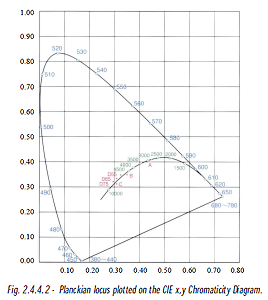Language of Light
2.Concepts
2.4 COLORIMETRY
2.4.4.2 COLOUR TEMPERATURE

The concept of colour temperature arises from the apparent colour changes of an object when it is heated to various temperatures. When the temperature of an object increases, the emitted radiation changes which result in the change of colour. A special class of incandescent (glow when hot) object emits radiation with 100 percent efficiency when heated; scientists call this ideal full radiator as blackbody radiator.
In particular, an ideal blackbody glows with a colour which depends on its temperature. The range of hues may be shown on the CIE diagram by a line which is referred to as a blackbody locus (or, Planckian locus). The colour progresses from a very deep red through orange, yellow, white and finally bluish-white as the temperature increases. Most of the natural light sources, such as the sun, star, and fire fall very close to the Planckian locus.
Some light sources have colour which corresponds to that of a full radiator when the latter is held at a particular temperature. For some purposes, it is convenient to classify such a light source by quoting its colour temperature (measured in Kelvins). Colour Temperature curves from 1,500K to 10,000K can be supplied. As long as the light being measured closely approximates a blackbody source, the results are quite accurate. Hence, the locus is particularly useful in the classification of ‘whites’. Colour temperature is widely used among lamp and display manufacturers.

